
Why Dive Boats?
The sea, being massive, can pose some logistical problems to a diver. Some dive sites require a diver to simply stagger off the beach into a beautiful coral reef or drop off, whereas some are much less accessible and require a boat to get to them. I am very partial to using a boat for diving as I find the sites tend to be a little less worn out by snorkelers, the above water locations (if near land) are more pristine and the boat is a nicely convenient place to set up your gear (versus setting up out the back of a truck or on a sandy beach). I am also acutely aware of how many people have never dived off a boat, or, have been on boats but don’t know the first thing about them. I hope to impart just a little marine knowledge throughout this article and possibly convince a few of you who are staunch shore divers to give boat diving a try.
Sailor’s Terminology
Anyone who speaks English will be familiar with many navel terms such as port and starboard, or galley and helm. But, could you place them on a diagram of a boat? If you were asked to go to the head, would you go to the wheelhouse by mistake? Let’s have a quick glance at some common marine language.
Bow – The front of the ship, the part where Leonard De Caprio and Kate Winslet ruined a perfectly good disaster movie.
Stern – The rear of the ship, the frothy part.
Port – The left hand side of the boat if you are facing the bow.
Starboard – The right hand side, not port…
Windward – The side facing the wind, the place not to throw up at.
Leeward – The side away from the wind, here’s where all the green faces go.
The Head – The WC, the bathroom, the gent’s, the throne, the porcelain god, etc…
Galley – The boat’s kitchen, but often not much more grand than a gas stove.
Wheelhouse – The cabin in which the helm (or wheel) is located, and occasionally a drunk captain if pirate stories are to be believed.
Transom – The flat platform at the stern of a boat that often acts as a diving platform, also where an outboard motor is attached to on a zodiac.
Rail – The fence that stops you from going overboard when being sick.
“Chunder” – Derived from “watch under”, shouted when using the leeward rail for evacuative medicinal purposes.
Classes of Boat
Boats are used for so many applications that there is a huge variation in design, shape and size of vessel. Because they are so different in design it is important to know what types of boat do what and how they do it (for instance, you wouldn’t want to book a diving trip on a Zodiac if you are very prone to seasickness being as they are very unstable)
1. Zodiacs (Inflatable Water Craft)
- These boats are usually between 3m to 6m long.
- A Zodiac is normally constructed from two big inflated tubes that form an arrow, this then has either a soft or hard hull between them. The deck may also be hard or soft. They require a hard transom (rigid plate) to affix the outboard motor to.
- They are almost unsinkable because the tubes are comprised of many individual compartments that are independent from each other. If one is torn, all the others remain buoyant.
- A zodiac is very sturdy and easy to tow behind a larger boat, but they are tricky to board and alight (especially from the sea) and they are often cramped for space.
- Only good for short trips on calm sea (if you value your spine or your constitution)
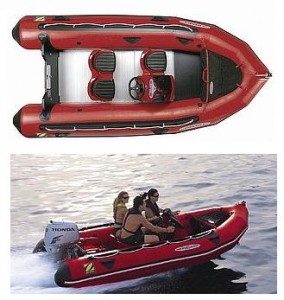
- Zodiacs are small, fast and robust.
2. Hard-Hull Small Boats (Skiffs)
- Usually ranging from 5m to 7m in length.
- Boats of this size are usually small dinghy style craft with medium powered outboard motors.
- Because this category of boat is used for many activities, it is best to use a specially designed diving boat so that there is plenty of deck space, a good dive platform and ample tank racks.
- These boats are still pretty small and are not for use in open, rough seas. They probably won’t have any place to make food or a suitable toilet.
- Seasickness nightmare as they tend to roll more than zodiacs.
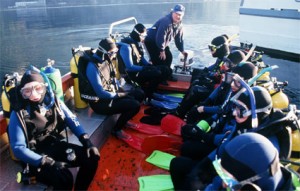
- Quick and agile but very cramped, skiffs are only good for short trips
3. One-Night Cruisers
- These vessels range from 5m up to 10m in length
- They are called “cruisers” because they are able to accommodate people for at least one night with basic amenities. (Think of a floating camper van and you’ll have the right idea)
- These boats will take around 8 divers in relative comfort. They may use power or sail to get there. These boats are a little more stable than the dinghies and will have the appropriate facilities to make food (a galley) and use the toilet (the head).
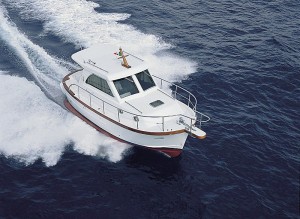
- Cabin cruisers provide much needed facilities for longer trips
4. Live-aboards
- These ships can be anywhere from 10m in length to hundreds of meters.
- These dive boats are designed to be lived on for anything from one night to three weeks. They may have anything from a few divers up to a few hundred. These are the big converted fishing boats right up to mega cruise liners
- Because of their size you will likely have your own cabin with full amenities. Often there will be other activities on offer such as windsurfing and island trips.
- Most huge ships are incapable of reaching delicate dive sites without damaging them or grounding the vessel, so it is common to dive from smaller craft when going on a big cruise liner dive holiday.
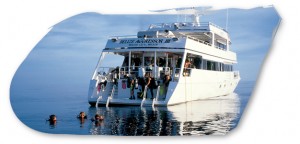
- Big live-aboards are luxurious but you won’t be diving solo…
Advantages of Boat Diving
Space – Unlike the back of a truck or the boot of a car, a dive boat is customised to accommodate bulky dive gear and aid the donning and doffing of awkward dive equipment. This space is also more secure than a car or beach (being manned by boat staff, rather than leaving a car by the side of the road or in a parking lot unattended).
Better Waters/Sites – The water off a beach is often poor for diving, usually the current/tidal systems off a mainland stir up sediment that can be avoided by simply going beyond them. A boat has the luxury of being able to go directly to the best site within its range.
Galley/Head – This might sound silly but the boat’s ability to serve a warm meal when it’s cold or a plate of sandwiches after a battling a hard current can really improve diver morale. Likewise, getting caught short on the beach with no toilet for miles can put a real downer on a good day. My personal favourite thing about diving from a boat is the fact that most of them have fresh water showers to wash the salt off – this makes me feel much rejuvenated after a long time in the brine.
Back Up Equipment/Tools/Medical Gear – A well stocked boat will be able to provide a rudimentary fix for almost any problem ranging from a missing O-ring to a contaminated tank to a nasty jelly sting. Even the most prepared shore diver’s car is unlikely to have a fix for every problem, and crucially it is unlikely to be anywhere near as handy as a boat (who wants to spend ten minutes getting into the water from the shore only to find that they have a leaky power inflater and need to walk all the way back through the surf and up the beach to change BCD, assuming they have a spare.)
Crew – This is a really under appreciated part of boat diving that can really make a difference to a diver’s comfort and safety. A boat might only have a captain or it might have a full compliment of boat hands and Divemasters who can prepare dive equipment, assist a diver into the water, organise dive parties and help clean up when the day is done. A helpful boat crew will make a good dive into a great one.
Entries/Exits – As mentioned earlier, entering and exiting the water from the shore can be both time consuming and dangerous in bad conditions. Whereas getting in and out from a boat is quick and convenient. It means that if a problem with the diver’s gear occurs the offending item can be replaced quickly.
Reduced Surface Swims – A dive boat will aim to put its divers right on top of the dive site which means less tired divers and more time diving on the good stuff rather than looking at sand on your way there. In an emergency situation a boat can come to the diver’s aid rather than having to exit the victim through surf from a long distance away.
Social Atmosphere – Dive boats are a veritable melting pot of different cultures and languages brought together by one passion. Where else could you see a web designer from Bangkok talking frantically about diving in the Maldives with a Norwegian lumberjack? Even if the diving was terrible you might meet a fellow diver who will have you in hysterics within five minutes of meeting him, you probably won’t get that on a beach.
How to Deal With Seasickness
Okay, I’ll confess, boat diving is not all roses and chocolate Easter eggs – sometimes it is made miserable by the green goblin of seasickness. Seasickness afflicts a large portion of people who use boats for diving. It happens for a number of reasons and has nothing to do with how much of a man you are. I know many macho men who laughed at me when I offered them seasickness tablets, the next time I saw them they were leaning over a rail and making funny noises. Seasickness is not a weakness and it can be prevented with the proper technique.
The Night Before – It should be an obvious statement to suggest that an experimental curry the night before your Open Water course begins is a bad move. As is sampling the area’s local wine, especially if it comes in three litre bottles. Hangovers really don’t work well with boats, even in calm water, and cancelling on a dive operation twenty minutes before the boat is due to leave just because you have a hangover is not cool either. If you want to drink then don’t book a dive for the next day.
The Morning Before – So, you’ve made it this far and you’re feeling good. Make sure you stay that way by avoiding an unsteady breakfast. Go for simple and non-volatile things like toast and cereal. Avoid coffee if you can and don’t go down the greasy fried breakfast route either. This is also the time to look at the directions on your anti-seasickness medication – often they need to be consumed at least an hour before stepping on the boat. Ensure you pay attention to this, they are little use to you when you are turning green. You should also take this time to sort out any delicate gear such as cameras or navigational maps because doing this on the boat is a shortcut to the Shrek theatre of guttural noises.
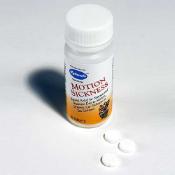
Prevention is better than cure, but take them well in advance!
On the Boat – Now you are on the boat and feeling good, don’t forget to pay attention to your stomach. All the old remedies help: sit in the middle of the boat, lower decks tend to rock less, stay out of engine fumes, stare at the far away horizon or another distant point and don’t read or mess with that camera!
If You Get Sick – If, somehow, you manage to get sick despite all my advice, you should redouble your efforts to only look at distant points. Consider standing up and countering the boat’s motion by riding it like a surfboard (bend your knees as the boat rises to keep your body still). If non of this works then a tactical tummy manoeuvre might just help you through the worst of it, in which case don’t use the toilet (for a number of reasons – mess, queues, bad smells make you feel worse etc.) use a discreet leeward rail (not into the wind, have the wind blow away from you) down stairs. Ask someone to come with you so they can catch you if you pass out and need to be dragged away from the perilous rail.
Closing Thoughts
I wanted to leave you with a reminder that boat diving is what diving is all about, it is the essence of why we dive – adventure, engineering, the beauty of nature, fun, social stimulus and laughing at that macho guy hurling his guts over the side of the boat.